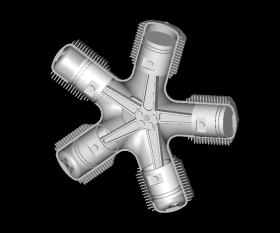So what is it? The most aged member of the Big Car series, the "Auto Chassis" from 1977. It was missing some parts but the seller was so kind that he sent all of them to me. By the way I am very happy with it. It feels like new, I did not find any broken or yellowish parts. My old Technic playing sets from the 80s are in a much worse shape by now.
After putting it all together I found comparison against the other Big Cars natural. Some numbers to start with:
- this is the oldest of all, sold from 1979
- this has the fewest pieces, 610
The power train makes a very massive impression, the four big cylinders after each other would be enough to drive a boat. The gearbox has two gears, in first gear the pistons literally "fly" - I am not sure that this lasts long under heavy playing. In the rear there is no differential. Instead, there is an universal joint keeping the two sides together. I think this can be really easily broken by the torque of the large wheels.
Besides the relatively simple basics there are a couple of interesting details. The first seats can be adjusted forward or rearward with a rack mechanism. The middle part of the rear seat can act as an arm support or can be hidden.
Until I saw it from photos only I did not realize that the engine is shifted one stud right from the centerline - I believe this gave more room to the exhaust and the gearbox. The proportions of the car are also somewhat surprising, it is not wide but very long, probably longer than any of the sportier subsequent models.
One more thing: the assembly instructions come on both sides of a single foldable sheet in 10 main and 27 secondary steps. For comparison, the instructions for the 8448 have more than 150 steps (and pages).
Now if only I would get an 8860... More photos in the album as usual.





